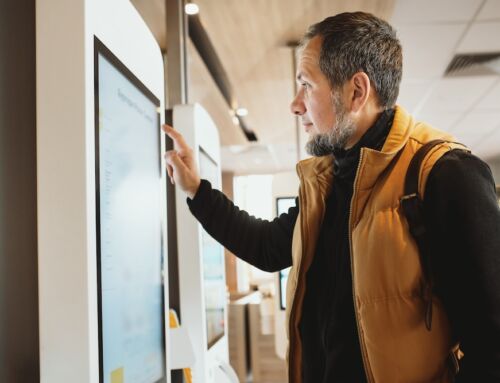Use cases for self-service kiosks are expanding rapidly. As a result, the form and function of kiosks is multiplying at a similarly advanced rate.
For example, at Acante we sell kiosks for three main purposes – identification and authentication, information and service or transactions. While all of our modular kiosks share the same brand design and core components, each kiosk we sell will vary according to the nature of the business, what it will be used for, where it will be located and various other factors.
A kiosk used, say, to sign visitors into a building will need different functions to a kiosk used for placing an order in a fast food restaurant. But even when kiosks are used for broadly similar purposes, say self-checkout in retail, the size and design of the kiosk will vary considerably from a supermarket to a small fashion boutique.
One of the great things about kiosks these days is the level of flexibility and choice available. But that does raise the question – how do you go about choosing the right solution for your business?
Here are a few pointers to get you started.
What do you want your kiosk to do?
This might sound like an obvious question but it’s worth spending some time thinking it over before you start looking at the kiosk options available. A kiosk should add value to your business in some way, whether that’s improving the customer experience by reducing queue times or providing useful information, freeing up staff time or anything else. How you see your kiosk adding value will go a long way to determining the features it will need to have.
For example, if you run a shop or a restaurant and want kiosks for customers to place orders and make payments, the key thing you will need is an integrated card reader. But you might also need a model with a barcode scanner so customers can scan items they want to buy.
If you want a kiosk to register and authorise visitors to your premises, you might want an integrated printer for issuing passes. But if you also want the same kiosk to be used for authenticating staff and other personnel, you might want to think about a biometric scanner to identify them by their fingerprints or face.
The great thing about modular kiosk design is that you can treat it like a technological pick-and-mix – there’s all sorts of functionality you can add with a range of add-on gadgets. The key is knowing what you really want to get out of your kiosk and picking the tools accordingly. And if you’re not sure, you can always ask your friendly neighbourhood kiosk experts like the Acante team!
Location, purpose, size – a three-point synergy!
The main component in any kiosk is the touchscreen. Take all the scanners, printers, card readers and the rest away, and you can still have a useful, valuable kiosk with just a touchscreen alone. In fact, many kiosks deployed as information points have nothing more than a touchscreen.
Picking the right size screen is one of the most important considerations when introducing kiosks to your business. There’s a balance here to be struck between location and purpose. If your premises are on the small side, you probably don’t want great hulking screens taking up valuable space. Then again, you don’t want to go so small that using them becomes fiddly.
As a rule of thumb, kiosk screens tend to be on the large side – larger than a typical computer screen. That’s because you want them to be accessible and convenient to all users. You also want them to be visible in your premises so people use them.
But at the same time, you don’t want to go so big that they get in the way. The utility of a kiosk is as much about fitting it into the design and layout of your premises as it is making sure they are easy to use. Again, our friendly team is more than happy to provide advice on this.




